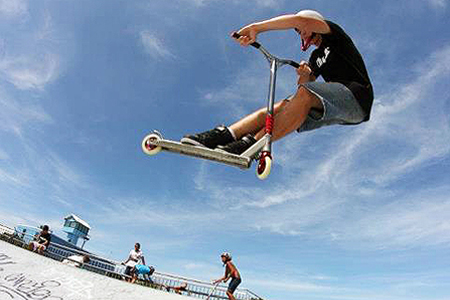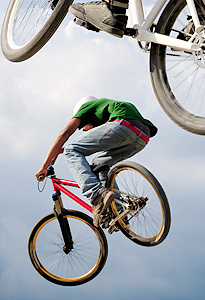Bicycle tyre technology - fitting
If you can't bring your bike in to us for a new tyre or tube here are some helpfull hints for doing it yourself.
When fitting a bike tyre and an inner tube, it is important to choose the right combinations of the four components that play a role in the fitting:
- rim
- rim tape
- inner tube
- tyre
The E.T.R.T.O. (The European Tyre and Rim Technical Organisation) has formulated guidelines to combine these components optimally.
The rim
Depending on the tyre width and the tyre pressure, a recommendation can be made about the rim type, rim width and type of rim tape. Note: Most tyres are tighter on SUN Rims. Hook Beaded rims are to be used for a tyre pressure from 5 BAR (75psi) upward. Carbon rims are usually not designed for pressures above 150 psi. Consult your rim manufacturer with regard to the maximum tyre pressure the rim will take. Remember, worn or old rims will not take the same tyre pressure as new rims. Below are examples of pressure ratings for some tyres.
| 700 x 23C Tyres | Recomended Pressure | Maximum Pressure |
|---|---|---|
| Vredestein Fortezza | 8.0Bar | 12.0Bar |
| Vredestein Volante | 7.0Bar | 11.0Bar |
| Vredestein Ricorso | 6.5bar | 9.0Bar |
The rim tape
For a tyre pressure from 5 BAR upwards, it is advisable to use a stiff, preferably self-adhesive rim tape, which covers the spoke apertures. The rim tape must touch the inside of both rim walls.
Latex inner tubes
During fitting, the size and type of inner tube used influences the final result. A latex inner tube requires special treatment. A 100% natural rubber latex inner tube has a high elastic deformation of about 900%.This means that the tyre can be stretched up to 9 times its normal size without damage. This will cause permanent deformation. In practice, this means that pumping it up before it is fitted can completely destroy the tube.
Gently inflate the latex inner tube by mouth only before fitting it, so that it adopts its round shape.
Butyl inner tubes
Standard inner tubes are usually made of butyl, a synthetic rubber with low gas permeability. We make a distinction between two types:
- Freely vulcanised.
- Vulcanised in a mould.
A freely vulcanised inner tube is easy to fit. Since a thin layer of talcum powder is present on this tube, it nestles more snugly inside the tyre than the version that is vulcanized in a mould. Inner tubes vulcanised in a mould have a ridge, which makes them more difficult to repair.
Here are the instructions for fitting a bicycle tire and tube:
Materials required:
Bicycle tire and tube
Bicycle pump
Tire levers (optional)
Instructions:
Remove the wheel from the bicycle frame. This can be done by releasing the brake if necessary and unscrewing the nuts or quick-release skewer that hold the wheel in place.
Deflate the tire by pressing the valve stem with your finger or using the valve cap to depress it. Make sure all the air is out before proceeding.
Use tire levers (optional) to loosen one side of the tire from the rim. Place the lever under the bead of the tire and pull up to pop it over the rim. Repeat this process around the entire circumference of the tire until one side of the tire is completely off the rim.
Remove the old tube from inside the tire, taking care not to damage the valve stem. Unscrew the valve cap and gently pull out the valve stem from the rim. Be sure to check the inside of the old tyre to make sure there is nothing still in the tyre that could cause the new tube to puncture straight away. Carefully run your fingers around the inside of the tyre to feel for anything sharp and inspect the outside of the tyre for any damage or remove anything still stuck in the tyre.
Take the new tire tube and lightly inflate it with a pump. Insert the valve stem into the valve hole in the rim, and tuck the rest of the tube inside the tire.
Begin by inserting one side of the tire bead back onto the rim, pushing it down with your thumbs. Work the rest of the tire bead onto the rim, working your way around until the tire is mostly back in place. If needed, you can use tire levers to help work the tire bead onto the rim, but be careful not to pinch the tube with the levers.
Check to make sure the tube is not twisted or caught between the tire and rim. Inflate the tire to the recommended pressure listed on the sidewall of the tire using a bicycle pump.
Once the tire is fully inflated, check to make sure the tire bead is properly seated on both sides of the rim. If not, deflate the tire and try again.
Finally, remount the wheel onto the bicycle frame, tightening the nuts or quick-release skewer to the appropriate torque.
Congratulations, you have successfully fitted a bicycle tire and tube! Remember to always check your tire pressure before riding to ensure a safe and smooth ride.




